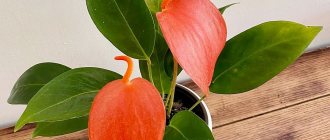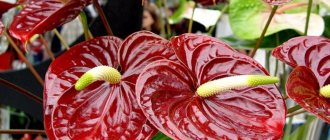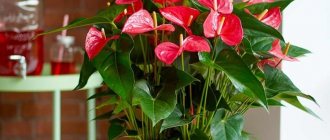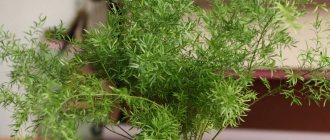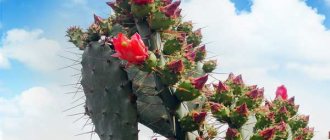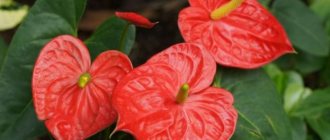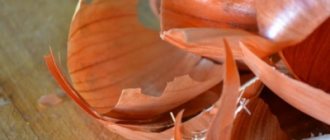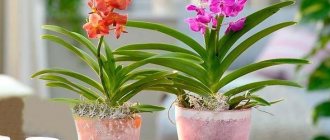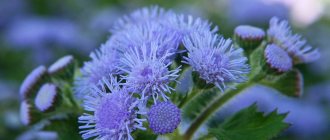Anthurium flowers amaze with their beauty. This tropical plant can bloom all year round if well cared for. They can be cut and formed into gorgeous bouquets.
Men's happiness is able to absorb kitchen odors and odors emanating from plastic, so by placing a flowerpot in the dining area, you will breathe clean air enriched with oxygen.
There are about nine hundred species of this flower in the wild.
Home care
Anthurium has its own care characteristics that should be taken into account when caring for the plant. And then it will delight you with almost year-round flowering.
Location and lighting
The subtropical guest prefers light and warmth. Only the light must be diffused. Also make sure that the flowerpot does not stand in a draft - this will not do it any good. If possible, take the flowertail outside in the summer. Only the place should be calm and slightly shaded from the sun.
The best place for anthurium is east or west windows. You can keep it on a southern windowsill in winter, but in summer it is better to move it to a table near the window. If the apartment's windows face exclusively north, the red tongue may not bloom. Therefore, be sure to add lighting in winter.
Temperature
Try to provide the anthurium with a favorable temperature regime. In spring and summer it should be warm: +22-28°C. In the cold season, maintain the temperature at least +16-18°C. If the room has less degrees than required, add additional lighting with a lamp. Otherwise, the red tongue may get sick.
Watering
In the warm season, water the anthurium 2-3 times a week. In winter, once a week will be enough. Fill in a lot of water. Before watering, let it sit and warm up to room temperature. To prevent the roots from rotting, wait until the soil becomes barely moist and only then water again.
Air humidity
The air humidity around the pot should be high to such an extent that droplets of moisture appear on the leaves. So take appropriate measures:
- you can spray the anthurium 2-3 times a day;
- spread the wet expanded clay in a tray and moisten it every day;
- cover the pot with sphagnum moss;
- place containers with water nearby;
- wipe the leaves with a damp cloth;
- Once a week, give your ward a warm shower for the leaves, having previously covered the soil with polyethylene, returning it to its usual place when the water has completely drained from the leaves.
Make sure that when spraying, droplets of moisture do not fall on the cob, otherwise the flower will become covered with ugly spots. If you accidentally drop it on a flower, immediately remove the moisture with a cotton swab.
The soil
The soil for anthurium should have good air permeability and be loose. Prepare the following composition:
- 40% peat;
- 40% turf;
- 20% crushed sphagnum.
You can take ready-made soil for begonias and add a little coconut fiber, coal, and chopped fern rhizomes to it.
It is advisable to season both the first and second options with small pieces of brick and pine needles.
Feeding and fertilizers
It is necessary to feed flowertail in spring and summer. Add mineral fertilizers once every 2-3 weeks. Only reduce the dose indicated on the package by half.
When replanting, add rotted manure. Don’t throw away the dry leaves, but dig them in the pot. They will rot and also turn into fertilizer. If you take the flowerpot outside, you can water it with a liquid infusion of chicken droppings.
Transfer
A young flower must be replanted every year. As a last resort, do it after two years. And adult plants can live in the same flowerpot even for three years in a row. Notice that the roots have become crowded, which means it’s time to replant.
Try to carry out the procedure in February-March. Handle the roots and leaves very carefully as they are thin and fragile. Choose a flowerpot a little larger than the previous one - literally 1-2 cm, since anthurium does not like space and may not release color in a container that is too large. Give preference to plastic, because it will be hot in a ceramic flowerpot. The container should be long and not very wide. Line the bottom with a layer of broken brick or expanded clay.
Please note that this flower is poisonous, so wear gloves. And choose a place such that neither children nor animals can reach it. If a leaf is bitten off, a food allergy may occur.
Reasons for the lack of color on anthurium
If there are no flowers, there is a lot of foliage, which means that the care provided by the gardener is not suitable for this plant.
And the reason may lie in the following facts:
- insufficient or excessive lighting;
- incorrect amount of watering (both due to little and too much);
- low humidity levels;
- lack of the required mineral composition in the soil mixture;
- irregular fertilizing;
- any deviation in the temperature of the content, especially during the formation of buds;
- size of the landing tank;
- the presence of any drafts;
- changes in places of cultivation and installation (this flower loves constancy too much);
- incorrectly selected container size;
- substrate composition;
- improper transplantation of an exotic plant;
- the presence of noticeable drafts in the room;
- pests;
- diseases;
- a large number of old faded buds that remain on the stem (after all, the process of forming seeds in them also requires the use of a powerful flow of energy).
Anthurium blooms only in the conditions it needs. The plant is capricious and does not forgive the mistakes of gardeners. The plant simply will not bloom in a large pot. The reason is that until the root system fills the planting container from the inside, the development of stems, leaves and budding are suspended.
If there are withered peduncles, you need to know that the cobs will take away the plant’s strength, which should be aimed at growing, strengthening the anthurium and the appearance of new buds.
Bloom
In order for the anthurium to have the opportunity to set buds, it is necessary to keep it cool in winter, lowering the temperature to 15-16 degrees. In this case, the ward will thank you with flowering throughout the summer. Some species produce color all year round.
After a month or a month and a half, the flower needs to be removed so that it does not begin to form seeds and take away the strength from the bush.
This representative of the Araceae family does not bloom only if the maintenance conditions are violated: temperature, humidity, lighting, watering. Do not overdry the soil or flood the soil too much. Fertilizers should be used. And then you will invariably see a bright pink cob framed by a blanket sheet.
Anthurium can be cut and formed into bouquets. The cut bud will last in the vase for about five days. And a flower that has already bloomed enough will not wither for 25-30 days.
Kinds
Anthuriums are the most numerous representatives of their family. According to some sources, the number of species of this plant is more than 500. But as it turned out, this is already outdated data; modern scientists have expanded the list to 900 items. The most popular in indoor floriculture are several species that are valued for their decorative qualities.
| Types and varieties | Description |
| Anthurium Andre | Herbaceous evergreen perennial. The leaves, similar to an elongated heart, are located on a long petiole and have a rather large size - length up to 30 cm, width - 10 - 12 cm. The surface of the leaf plate is dense, semi-glossy, green in color. The broad-heart-shaped spathe is slightly wrinkled, with pronounced veins, and glossy. The color can be different - salmon, pink, red, less often white. The inflorescence is a yellow spadix up to 10 cm long, erect or sometimes drooping. This species is very decorative and is very popular among gardeners. |
| Anthurium Andre Champion | A varietal plant of medium size and surprisingly beautiful dark green foliage. The flowers are small, but Champion is famous for their abundance. The color of the bedspread, depending on the variety, can be pink or white with a slight yellowish tint. |
| Anthurium Scherzer | Epiphyte, sometimes a terrestrial plant with a short stem. The petiole on which the leaf is attached has a length of 4 to 20 cm. Elliptical or lanceolate leaves with a pointed apex have a dense structure. The surface is glossy on top, matte on the bottom. The color is dark green. The distinctive feature is the flower. The bedspread is painted in red-orange color, which does not lose its brightness for a long time. The surface is glossy, the structure is medium density. The inflorescence is a spirally twisted ear, colored yellow or orange. One of the most popular potted species. |
| Anthurium crystal | Leads an epiphytic lifestyle. The leaves are large, almost 40 cm in length. They have an elongated oval shape, with a pointed apex. Deeply lobed at the base. Prized for their unusual color. Against a dark green background, the vein areas, painted silvery-white, stand out in contrast. The blanket is small - up to 9 cm, semi-leathery, green. The inflorescence is a yellow spadix tapering towards the apex, 12 cm long. |
| Baker's Anthurium | Epiphyte with stems 10 cm long. The leaves are narrow, elliptic-lanceolate, from 20 to 55 cm long. The leaf blade is matte, dark green on top, lighter on the undersides. The flowers are inconspicuous, located below the foliage level. The cover is small, from 2.5 to 5 cm long. The surface is leathery, painted in pale yellow-green tones. There is a purple border along the edge. The inflorescence is an 11-centimeter spadix of white-cream color. |
| Anthurium mix | This is a group of hybrids obtained on the basis of common species - Andre and Scherzer. Perfectly adapted to home conditions, they do not require special attention. As a rule, these plants have compact sizes and a variety of colors of bedspreads. |
Species and varietal diversity of anthurium - photo gallery
Andre's anthurium flowers captivate with their beauty
Anthurium Andre Champion has slightly smaller flowers, but more in number
Anthurium Scherzer is distinguished by a spiral-shaped inflorescence
Anthurium crystal has luxurious foliage
Baker's Anthurium looks completely different from other species
Anthurium mix - color variety of hybrid plants
How to choose a flower
It is best to buy a pot with a ready-made plant in the summer. During this period, anthurium has a lot of strength and will more easily endure acclimatization in new conditions. Under no circumstances should you place the potty in the bedroom. Only in the kitchen or living room.
Take a close look at the copy offered for sale:
- all parts must be proportional;
- the pot should not be too small;
- the roots should not come out of the holes at the bottom;
- there should be no pests on the bottom of the largest leaves;
- there should also be no gray or black spots on the leaves;
- the soil in the container should be moist;
- A flowering plant must have unopened buds.
What are the difficulties when growing and maintaining anthurium?
Diseases of the root system can lead to withering and death of the plant. This can also happen if there is hardened soil in the pot. In these cases, transplantation helps, which is preferably done once a year. To do this, with extreme care, the anthurium is removed from the container and planted in a new one, with soil and the addition of bark, moss and charcoal. After that, the dried leaves are removed and the trunk is sprayed with water. During the period after transplantation, it is worth feeding the plant with fertilizers based on mineral elements, as well as vitamins.
The wilting process can be caused by a lack of sufficient heat. In addition, the plant begins to wither in the presence of a disease such as fusarium. The process can also be caused by excess moisture in the soil, infections that occur through contact with pets or the gardener’s dirty hands.
Flower growers cannot help but make mistakes when growing such a whimsical plant as anthurium. But in order to avoid them and minimize them, it is worth knowing the basic rules for caring for it. Poor growth and development of the bush can be caused by a lack of lighting and watering. If this happens, then you need to feed the flower for better growth.
Fortunately, the flower is extremely rarely susceptible to disease. Diseases and pests in anthurium can occur due to improper care. Yellow leaves appear due to lack of sunlight. When the foliage darkens and begins to rot, this indicates that the room is not warm enough. The main pests of anthurium are aphids and scale insects. Failure to wipe the leaves can lead to spider mites.
How to rejuvenate anthurium
A bush with a considerable age has a bare trunk. This is due to the fact that the lower leaves gradually die off. As a result, the flowers become smaller or even do not appear at all. What to do in this case? Rejuvenate your pet.
During transplantation, cover the top with moss and wait for roots to appear. After this, separate the cuttings and plant them in a pot. You can cut off the apical stalk along with the aerial roots and place it in a jar of water. Just make sure the outlet is outside. In this case, there is a danger of the sprout rotting.
And in order not to mess around, you can restore your former youth by polishing the leaves with special polishes. This procedure will not only give the plant beauty, but also create a protective barrier for pests.
What it is?
Anthurium is a genus of evergreen plants that belong to the Araceae family .
There are species with short stems and aerial roots, as well as species with long vines. The leaves are all fatty, juicy, and come in different shapes - cut or whole. The sizes of the leaf plates can also be different - some types reach 1 meter. The foliage is decorative - many of the species are velvety, with light veins or a satin tint. Anthurium flowers are bright, original in appearance, the buds are collected in dense inflorescences. After the buds fade, fruits similar to berries appear on the shoots.
Anthurium is a whimsical, capricious plant that requires constant maintenance of certain conditions. In total there are more than 500 varieties. This family is considered one of the most numerous.
This plant is also popularly called “male happiness.” It is often paired with spathiphyllum, which is called “female happiness.” It is believed that if these plants are present in the house, mutual understanding and harmony will reign in the family.
The plant does not release toxic substances into the air, but its juice in contact with mucous membranes can cause burns. And if swallowed, it can lead to poisoning.
Reproduction
Anthurium can be propagated in different ways. And they are all about equally successful.
Dividing the bush
This method is most often used. During transplantation, carefully divide the bush into two or three parts. Make sure that each of them has a growth point. Do not use a knife, tear it off with your hands. Otherwise, you may damage the delicate roots. Plant each of the divisions in a separate pot. Water well and place close to light, but not in direct sunlight. Start feeding new plants after a month.
By shoots
Solid anthuriums gradually acquire side shoots. You can separate them and plant them in a separate container. Do this during transplantation to avoid damaging the roots. And if you urgently need to get a shoot, then remove the bush from the pot along with the earthen lump and carefully separate the planting material.
If there are very few roots on the shoot, first plant them in sand for rooting, covering the top with an inverted plastic bottle. Keep in a warm place, ventilating the sprout from time to time. After roots appear, transplant into a pot.
Cuttings
Separate the cutting. Air dry it for a quarter of an hour, then place it in a jar of water. Stretch polyethylene over the top. Wait until the roots appear in about a week and plant the man's happiness in the soil mixture.
Leaves
Cut an anthurium leaf, roll it into a tube and tie it with woolen thread. Stick halfway into the peat moss mixture, moisten thoroughly and cover with a jar. Keep in a dark place for three weeks. When a sprout appears, move it to light, but not to the sun. After three days, remove the jar. After a month, transplant it to a permanent place.
Seeds
Having purchased anthurium seeds in a store, sow them in peat, sprinkle the surface and cover with cellophane film. Shoots will begin to appear gradually in a couple of weeks. Wait until all the seeds hatch, then remove the film.
Continue spraying the seedlings with a spray bottle. Dive into 10cm pots after the third leaf appears.
If you decide to collect seed material yourself, be sure to carry out pollination. Use a brush to transfer pollen from one flower to another. Repeat the procedure after two days. To be sure, you can do this again.
For the fruit to ripen, wait 8-10 months. After this, remove the seeds, rinse and soak for 2 hours in a weak solution of potassium permanganate. Then immediately plant them in the soil mixture, sprinkling a layer of perlite on top.
Scatter the seeds over the surface, lightly press them into the ground and spray. Place glass on top. Keep the seedlings at a temperature of +22 degrees for two weeks. Then the first shoots should appear.
Wait for a pair of leaves to form and plant the sprouts in small pots. As soon as they grow up, transplant them into larger containers. They should bloom in 2 years. At first the flowers will be weak, but every year they will improve their appearance.
Tips for transplanting and planting
Before planting or replanting an anthurium, prepare everything necessary so that the plant does not experience discomfort after the procedure.
Capacity requirements
Anthurium does not require a large pot. The volume of the container should slightly exceed the size of the plant’s root system. In a container that is too large, there is a danger of the soil becoming waterlogged, which means the roots will suffer. The material from which the pot is made matters. Many gardeners prefer to grow in plastic pots. But based on my own experience, I can note that anthurium also performs very well in ceramics.
Select the pot for anthurium according to the size of the root system
The pot for replanting must have drainage holes to drain water.
The soil
This is perhaps the main requirement in the process of transplanting or planting. Anthurium will not grow in randomly acquired soil. The soil should be close to natural, which means it should have sufficient looseness, moisture and air capacity. The reaction should be slightly acidic - pH 5.0 - 6.0. It is easy to prepare such a substrate yourself by purchasing the necessary ingredients in advance. There can be several compositions, the main thing is to mix all the components well.
- 2 parts each of moss and peat, 1 part turf soil;
- in equal quantities peat, deciduous soil, coarse sand, coniferous bark and charcoal;
- 2 parts small pieces of pumice (1 - 3 cm), 2 parts pine bark, 1 part coarse fibrous peat, 1 part well decomposed horse manure.
The soil, consisting of large particles, will hold the plant in place well, and at the same time will not quickly disintegrate and compact. Thanks to this, the soil breathes well and allows moisture to pass through.
The soil mixture for anthurium, composed of large particles, perfectly holds the plant in the pot and does not caking
When to transplant
For a young plant, replanting is carried out annually, each time slightly increasing the volume of the container. Adult anthuriums no longer need to be disturbed as often. For them, the planting process is carried out once every 3–4 years.
Usually, replanting is done in the spring, at the moment when the plant comes out of the dormant period and begins to grow rapidly. But there are times when it is urgent to replace an old container with a new one. This can happen if the purchased anthurium is in waterlogged soil or the root system has become too crowded in the old space and the roots have already begun to grow through the drainage holes. Also, an urgent transplant is required if the disease is detected.
An anthurium bought in a store needs to be replanted.
Landing process
2–3 days before transplanting, water the anthurium generously. If the plant has not been watered for a long time, its roots will be very fragile and may break during transplantation.
Anthurium has very fragile roots, so the plant needs to be watered 2 - 3 days before planting.
- Take a new container with holes in the bottom. Be sure to put a drainage layer. Sprinkle some prepared substrate on top.
- Remove the plant from the old pot, holding the base of the bush with one hand and firmly grasping the bottom of the container with the other. Try to act carefully so as not to damage the roots.
- If possible, remove old soil from the roots. If the leaves show signs of disease, pay attention to the root system. Inspect it, remove rotten areas and fill the wounds with activated carbon.
- Place the anthurium in the center of the pot and add new soil mixture around the edges. At the same time, you can lightly tap the pot on the table surface to help the soil fill the space in the roots more evenly.
- When replanting, deepen the anthurium slightly so that the new roots are hidden in the soil. But do not overdo it, otherwise the plant may rot.
- Water the anthurium moderately if it was transplanted into dry soil, but water the wet soil only after the soil mixture has dried.
- Place the transplanted flower in a place inaccessible to sunlight.
- For better survival, you can spray the leaves with a solution of Epin or Zircon. But before that, be sure to read the instructions.
Secrets of transplanting anthurium - video
Diseases and pests
If you care for anthurium incorrectly, you can provoke the appearance of diseases.
Anthracnose
With this scourge, brown spots appear on the stems and leaves. Gradually they become brown and dry out. The plant will die if rescue measures are not taken in time. Remove infected areas and treat the remaining areas with fungicides.
White rot
The leaves become covered with a white coating, losing their natural color. The disease usually begins on the lower leaves. Fungicides or Bordeaux mixture will help cure flowertail.
Soil fungi
Replanting into new soil will help. Remove damaged roots and treat healthy ones with potassium permanganate.
Gray mold
Replant into a new pot, increasing the drainage layer, and then regularly ventilate the room.
Parasites
In addition to diseases, the plant can be attacked by spider mites, scale insects, thrips, and aphids. They should be gotten rid of with insecticides or acaricides. You can try soaping the leaves with a solution of laundry soap. Leave for several hours, then rinse.
To summarize
A noble plant from the Amazon delta will decorate any interior, giving it a special chic and shine. Elegant flowers and leaves will renew the apartment, give warmth and comfort in the winter cold, and add bright colors to the gray atmosphere of everyday life. In combination with other exotic plants, the flamingo flower will fit into a miniature corner of a green tropical paradise in your home.
Anthurium is blooming like crazy, I’m revealing secrets.
Anthurium: types and varieties, planting and care at home, propagation, replanting | (Photo & Video)
5 Total Score
Customer ratings: 5 (1 vote)
Care errors
Carefully monitor the green ward to eliminate all the shortcomings in time:
- the tips of the leaves have dried out - heat the bush under a table lamp with a regular light bulb;
- the leaves are curled into a tube - fill the tray with wet expanded clay, and place a wet rag on the battery;
- the leaves have withered and black spots have appeared - replant the plant in soil for bromeliads;
- brown spots sprinkled on the leaves - eliminate the draft and move the pot away from the window;
- plaque appears on the leaves - treat with an anti-fungal agent;
- the leaves have turned yellow - eliminate the cause.
To prevent leaves from yellowing:
- water your pet with soft, not cold water;
- add nitrogen to the soil;
- do not spray in direct sunlight;
- increase daylight hours.
Flower diseases Male happiness
The plant begins to get sick if it is not cared for properly. What is detrimental to anthurium?
- Dark spots on the leaves appear if the flower is kept in a room with low temperature for a long period. It is enough just to place the anthurium in a warm room and reduce watering
- The plant can be affected by mealybugs. The pest inhabits the above-ground part of the plant. It is not difficult to detect the presence of mealybugs: the shoots become covered with cracks and the leaves become covered with spots. If you do not help the plant, the leaves will begin to fall off. You can destroy the pest by treating anthurium with Karbofos
- Blackening of the tips of the leaves is associated with an excess of calcium salts in the soil. The plant needs urgent transplantation into soil suitable for anthurium.
- Dark spots on the bracts are caused by drops of water when spraying. Affected flower stalks should be removed
- When a plant is infected with avocado scale, the leaf plates become covered with a sticky coating. To combat the pest, you can wipe the leaves with a sponge soaped with laundry soap or treat the flower with 2% Karbofos.
The plant can be affected by fungal diseases:
- gray rot (the plant becomes covered with a gray coating, which is formed by fungal spores) - with excessive humidity. To save the flower, it should be placed in a ventilated area and treated with “Topsin”
- septoria (a brown coating appears with darkish dots on the leaf blades, the edges of the affected areas form a light border). Treatment consists of removing the affected leaves and treating the anthurium with a low concentration solution of copper sulfate or copper oxychloride
Folk signs
Anthurium is often called “male happiness.” According to legend, this red flower must be present in a bachelor’s house. He will help him find his soul mate. In addition, it affects male strength, so there will be no misfires during lovemaking. It will also help fight alcohol or nicotine addiction.
If a married couple’s relationship is not going well, the flamingo flower will also help restore it. The spouses will make peace, and their life together will sparkle with new colors. For complete harmony, you should also acquire “female happiness” - spathiphyllum.
It also wouldn’t hurt for women to get a flower tail. After all, red color, according to Feng Shui, attracts wealth. To achieve what you want, however, you will need to take good care of your pet.
For people born under the sign of Leo, this flower will become a patron. It will also help timid people to become bolder, and those immersed in their own thoughts to pay attention to the feelings of others. Anthurium improves mood and relieves fatigue.
For a beautiful plant to be useful, it must be given to you as a gift. And you yourself will definitely give a flowerpot with a flower to the newlyweds on their wedding day so that their life will go well.
Short description
Anthurium magnificum
The plant is loved due to the beauty of the “sail” of the flower. The flower itself is a cone and is unremarkable. But it is enveloped by a blanket sheet of various shapes and colors. After flowering, it turns into an ordinary green leaf.
Characteristic features of anthurium:
- bush height – 40-80 cm (depending on the variety);
- superficial root system and the presence of aerial roots;
- leaves in the shape of a heart, blade or oval, sometimes with cuts;
- usually the leaves are hard; glossy or matte;
- the flower looks like a cone, a spiral, sometimes in the shape of a ball;
- The shape of the bracts is oval, varies among different species;
- the sheet-bedspread has a rich range of colors;
- The aroma of the flower is delicate, but can also be unpleasant.
Indoor anthurium cannot be called unique: easy care and beautiful appearance have made it a common inhabitant of apartments. The plant can bloom all year round. But in its “life routine” cyclicality is also possible: 3 months of flowering and 3 months of rest.
Among gardeners, the plant is called the flamingo flower, and among the people it is called “male happiness.” It is believed that the flower gives a man masculine strength, self-confidence, courage and determination in his actions.
Medicinal properties
By placing a pot of anthurium on the windowsill, be sure that it will not allow staphylococcus, streptococcus and Pseudomonas aeruginosa to develop in the room.
The contents of the flower are also indicated for heart patients and people with hematopoiesis problems.
Traditional Hawaiian medicine recommends using the roots to relieve headaches, and tea from the leaves to treat whooping cough. But it’s better not to do this yourself. After all, if you only slightly exceed the dosage, you will end up with a bunch of health problems instead of healing.
During the flowering period, the strong aroma can cause insomnia. Some people are allergic to anthurium pollen. The juice of the plant, if it gets on the skin, causes irritation.
But don’t worry: no one has yet been seriously harmed from the poisonous properties of anthurium. If you follow precautions, then everyone in your family will remain alive and healthy. But you will admire the bright colors of the wax cobs for a long time.
4.Varieties of anthurium:
4.1. Anthurium Andreanum
A very common spectacular tropical plant. This type is often used in compositions and wedding bouquets. Very decorative in warm periods. Long-term flowering, almost all year round. The flowers are glossy red, pink, white or orange, heart-shaped, actually a spathe, with a white spadix densely covered with tiny flowers. The leaves of this large anthurium are dark green, long, leathery and located on a vertically growing stem. Bedspreads can maintain an attractive appearance for several months. Pollination of flowers significantly shortens the flowering time - in this case, the bedspreads will also lose their decorative effect ahead of time.
↑ Up,
One of the most spectacular varieties of this subspecies is Anthurium Amalia Elegance - a beautiful low plant with emerald green leaves and flowers collected in inflorescences - pink or lilac-colored cobs. The main attractiveness of the plant is the elongated white blanket with a pink tip and veins surrounding the flowers.
↑ Up,
Anthurium Dakota - Anthurium " Dakota " , belonging to the same group, has large, glossy, rich burgundy blankets with pronounced veins and yellow inflorescences - cobs, and is distinguished by its gigantic size - it can reach a height of 1 m.
↑ Up,
Anthurium Cavalli - Anthurium "Cavalli" is a plant with delicate pink or lilac glossy covers and dark - often even purple - ears on tall leafless peduncles. The large-flowered anthurium Fiorino is similar in appearance , which is also distinguished by an unusual purple hue of the bedspreads, however, the bedspreads of this variety are more glossy and oblong, without pronounced veins on the surface.
↑ Up,
Anthurium Andre Leganza - Anthurium Leganza is a beautiful lush small-leaved bush with dark green leaves and beautiful spathes, painted in delicate pastel colors - a combination of light green and pink. Inflorescences - the cobs are painted in a bright orange or pink hue.
↑ Up,
Anthurium Picasso - Anthurium Picasso - a plant distinguished by its unusual, bright yellow color of the bedspreads, perfectly contrasting with the matte dark green leaves.
Often on the Internet you can find photos of blue or blue anthurium - such plants do not exist; the bright shade of the bedspreads is given by dyes that are watered on the bushes or injected directly into the flower stalks.
↑ Up,
4.2.Scherzer's Anthurium - Anthurium scherzerianum
Also a common species, the flowers have a red oval spathe, with an orange-colored spadix densely covered with tiny flowers. A distinctive feature of this variety is the inflorescence curved in a spiral - the cob. Flowering lasts about 2 months. Large, pointed, dark green leaves, 18 cm long, surround upright stems. Unlike Andre's anthurium, the leaves of these plants do not have a notch where the petiole is attached, and the cylindrical flower stalks inside the spathe are bent in the shape of a pig's tail.
↑ Up,
4.3. Anthurium crystallinum
A stunning large-leaved decorative anthurium, which is more likely to belong to decorative foliage plants. It has large heart-shaped leaves on tall, thick petioles. The leaf blades are dark green, as if velvety, with a bluish coating. Distinct leaf veins are highlighted in a lighter, silvery shade. The leaves are unusually thick and hard, reaching a length of 50 cm. The flowering is inconspicuous and is not of particular interest. The inflorescences of this species are thin, long, yellow, surrounded by small greenish or white blankets.
↑ Up,
4.4. Anthurium Turenza
Medium-sized flowering evergreen bushes with large, dark green, glossy, heart-shaped leaves on long, thin petioles. The bedspreads are large, bright, pinkish-red. Inflorescences - cream or yellow hues contrast perfectly with the spectacular bedspreads.
↑ Up,
4.5.Hooker's Anthurium - Anthurium hookeri
A large decorative foliage variant that forms a basal leaf rosette resembling a bird's nest. The leaves are green, glossy, broadly elliptical, on short, strong petioles. The leaf blades have corrugated edges. During the flowering period, erect, leafless peduncles appear in the rosette, at the top of each there is a narrow, small light green blanket surrounding a purple or cream-colored cob. Flowering is not of particular interest.
↑ Up,
4.6. Veitch's Anthurium - Anthurium veitchii
A giant, large-leaved epiphytic plant with narrow, heart-shaped, glossy dark green leaves. There is a wide light stripe along the central leaf vein, and the lateral veins are deeply recessed into the leaf blades. When grown in optimal conditions, the leaves can reach a length of 2 m. The flowers are yellow or light green, collected in cylindrical cobs and surrounded by a small greenish blanket.
↑ Up,
4.7. Anthurium Sumi
A beautifully flowering variety up to 60 cm high. The leaves are dark green, shiny, heart-shaped, on long petioles. The inflorescences are straight, pinkish, orange or yellow, surrounded by large, wide, white blankets.
↑ Up,
4.8.Majestic Anthurium - Anthurium magnificum
Ornamental deciduous evergreens with wide, attractive heart-shaped leaves. The leaves are painted in a dark, bluish-green tint, while the leaf veins are highlighted in a lighter, bluish color. The leaf blades are velvety to the touch and have a lighter tone on the underside. The leaf petioles are long and tetrahedral. Young leaves may have a brownish or bronze tint. The flowering is inconspicuous - this species probably has the smallest, pale green cover of all anthuriums.
↑ Up,
4.9. Anthurium Clarinervium
Bright ornamental plants with large, heart-shaped leaves 15 - 30 cm long. Leaf blades are dark green or bluish green, entire, leaf veins are highlighted in a contrasting light shade - light green or bluish. Young leaves are brown or bronze. The lower surface of the leaves has a lighter shade. The flowering is inconspicuous.
↑ Up,
4.10. Anthurium polyschistum
At first glance, it is difficult to classify this plant as an anthurium - it is so different from them in appearance. This species is not widespread in our country, but in Europe it is a common ornamental foliage plant. The leaves of the plants are complex, fan-shaped, on long, light green petioles; adult bushes form stems. Leaf segments are glossy, dark green, narrowly lanceolate or linear. The edges of the segments are covered with vaguely defined denticles, often corrugated. Flowering is not of particular interest and often goes unnoticed - the long, green ears of these plants are surrounded by light green, narrow spathes.
↑ Up,
After purchasing an anthurium, check the soil moisture
As soon as you receive a parcel with anthurium or buy it in a store, check the soil moisture. The shipment may take several weeks and the soil of the plant may dry out completely along the way. In stores, too, they do not always pay due attention to the plants and often dry them out or, on the contrary, flood them, so that they begin to hurt and rot. Often anthuriums brought from abroad are in transport soil (temporary), which must be replaced after purchase. If you bought an anthurium in our nursery, you do not need to change the soil, but you must water it, since when sending anthurium by mail, we deliberately do not water it for several days. A humid environment in the absence of light can provoke root rot.
Flower of male happiness: signs and superstitions
- The anthurium flower helps representatives of the fair half of humanity improve their personal lives. You just need to purchase it and provide the flower with good conditions. Then streams of male energy will rush into the house where a lonely girl or woman lives, and the problem will disappear by itself
- If quarrels and disagreements begin in the family, then to stop such scenes it is worth buying anthurium. Together with an indoor flower, stability will reign in the house, relationships will become harmonious, and mutual understanding will appear between spouses
- However, in order for everything to change for the better in the family, it is necessary to take into account the following: the male happiness flower can cope with the mission entrusted to it only in pairs with another flower - spathiphyllum. This houseplant represents a woman's happiness
- Spouses should share responsibilities for caring for flowers: everyone should take care of and cherish “their own happiness”
- The flower is also worth getting for those who suffer from cardiovascular diseases. As can be understood from the name “male happiness”, anthurium can relieve purely male ailments – sexual problems. A man's virility increases and his health improves
- Several “male happiness” flowers in the house will help improve your financial situation. But flowers will attract money only if they are healthy and well-groomed
- Anthurium is a good healer and for those people who feel a loss of strength and often get sick. Its powerful energy helps restore strength. Depressed people stop feeling depressed
The donated plant has strong properties. This is why anthurium is often given to men as a gift.
Buy a rooted baby or flowering anthurium
You can buy one blooming Anthurium, depending on the variety and age of the flower, in the range from 600 to 700 rubles. A rooted shoot (baby) of anthurium can be purchased from 350 rubles. If the cost of ordered indoor flowers (plants) is 3,000 rubles or more, then we add one plant for free. The minimum amount for any purchase is 1000 rubles.
We do not send plants by cash on delivery!
For the availability of anthuriums in our nursery, see the “Anthurium Catalog” section.
When choosing anthuriums, instead of the name, you can indicate the number of the flower in the photo.
Catalog of anthuriums: photos and descriptions.
Why do the leaves of the flower Man's Happiness turn black?
Anthurium leaves can turn black when overwatered. Therefore, you should not water the flower more than once a week in winter and once every 4 days in summer. Watering is not abundant. Abundant and frequent watering leads to rotting of the roots and blackening of the leaves.
How to save a damaged plant? Stop watering and dry the soil. But rescue must begin when the first signs of blackening of the leaves appear.
Damaged leaves
